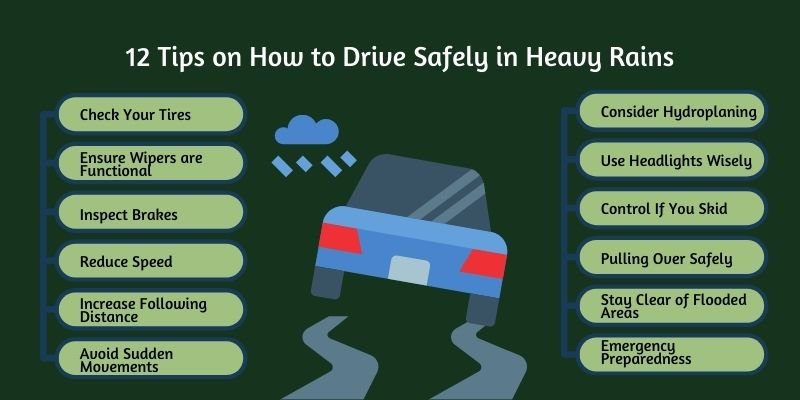Driving in rain and snow presents unique challenges, including reduced traction, longer stopping distances, and poor visibility. Without the right precautions, accidents can happen quickly.
Follow these expert safety tips to stay in control and protect yourself on wet and icy roads.
1️⃣ Slow Down & Increase Following Distance
🔎 Why It Matters: Wet and icy roads reduce tire traction, making it harder to stop.
🛠 Safe Driving Tips:
✅ Reduce speed by at least 30% in rain and 50% in snow.
✅ Keep at least 5-6 seconds of following distance between you and the car ahead.
✅ Avoid sudden acceleration or braking to prevent skidding.
🚨 Braking too hard on ice or water can cause you to lose control!
2️⃣ Use Proper Braking Techniques
🔎 Why It Matters: Slamming the brakes on wet or icy roads can cause skidding.
🛠 How to Brake Safely:
✅ If you have ABS (Anti-lock Braking System), apply steady pressure on the brake pedal.
✅ Without ABS, pump the brakes gently to avoid locking the wheels.
✅ Brake sooner than usual—it takes longer to stop in slippery conditions.
🚨 If your car starts to skid, steer gently in the direction you want to go!
3️⃣ Check & Maintain Your Tires
🔎 Why It Matters: Worn tires lose grip faster on wet or snowy roads.
🛠 Tire Safety Tips:
✅ Ensure tire tread depth is at least 2/32” (use the penny test!).
✅ Use winter tires for snow and ice—they provide better traction.
✅ Keep tires properly inflated—check PSI regularly in cold weather.
🚨 Underinflated or bald tires increase the risk of hydroplaning!
4️⃣ Avoid Hydroplaning on Wet Roads
🔎 Why It Matters: Hydroplaning happens when your tires lose contact with the road surface due to water buildup.
🛠 How to Prevent It:
✅ Drive in the tracks of the car ahead to avoid deep water.
✅ If you start hydroplaning, ease off the gas and steer gently—don’t brake suddenly.
✅ Avoid driving through deep puddles—water can damage brakes and engine components.
🚨 If the steering feels light or unresponsive, you may be hydroplaning!
5️⃣ Keep Headlights & Wipers in Good Condition
🔎 Why It Matters: Reduced visibility in rain and snow increases accident risk.
🛠 Visibility Tips:
✅ Use low-beam headlights (never high beams) in fog, rain, or snow.
✅ Replace worn wiper blades to keep your windshield clear.
✅ Keep defrosters and heaters working to prevent windshield fogging.
🚨 Turn on your lights in bad weather—even during the day—to help others see you!
6️⃣ Be Cautious on Bridges & Overpasses
🔎 Why It Matters: Bridges and overpasses freeze faster than regular roads.
🛠 Safety Tips:
✅ Approach bridges at a steady speed—avoid sudden braking.
✅ Watch for black ice, which looks like wet pavement but is dangerously slick.
✅ Keep a light grip on the steering wheel—jerking the wheel can cause sliding.
🚨 Black ice is nearly invisible—if the temperature is near freezing, drive with extra caution!
7️⃣ Prepare an Emergency Kit
🔎 Why It Matters: Getting stranded in bad weather can be dangerous.
🛠 What to Include:
✅ Jumper cables & flashlight
✅ Ice scraper & de-icer
✅ Blanket & extra warm clothes
✅ Non-perishable snacks & water
✅ Portable phone charger
🚨 Always keep your gas tank at least half full to prevent freezing fuel lines!
Stay Safe on the Road – Visit Onsite Auto Services!
🚗 Need a winter car checkup? At Onsite Auto Services, we offer tire inspections, brake checks, and battery tests to prepare your vehicle for rain and snow.
📞 Call us today or schedule an appointment online for winter driving safety services!
“Stay safe on wet and icy roads! Learn expert tips for driving in rain and snow, including braking techniques and tire maintenance.”
WinterDriving #RainyWeatherDriving #CarSafety #TireCare #BrakeSafety #AvoidHydroplaning #SafeDrivingTips #RoadSafety #AutoRepair #MechanicNearMe

